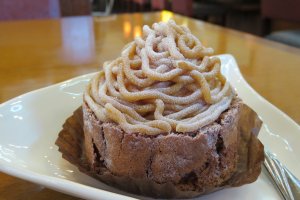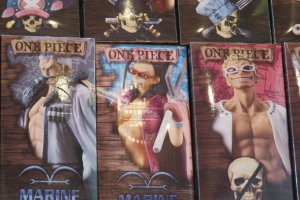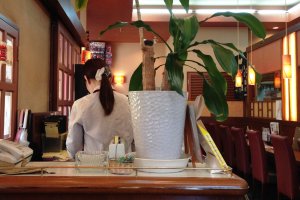When I asked the waitress what is the most popular dish at Haruki Tea House, she looked incredulous. She opened the menu book, flipped through it and after a nervous pause, said everything is popular.I was stumped. A Japanese language menu, though visualised with pictures, left me undecided. I then looked up and read the writing on the wall. "To the sun, to the sea, to Mother Earth, we give you thanks." Here at Haruki they treasure all the produce, whether it is from the sea, the air or from the ground. Maybe I shouldn't have pressed her.
The set menus are pretty popular she said, and so I ordered the shrimp fry set, though the oyster or kaki fry set was very tempting as well. Fried shrimp is a good example of yoshoku, western influenced Japanese food from the 19th century, though some recipes hark back to the an earlier time, when Portuguese or Nanban southerners as they were called by the Japanese, would connect Japan with the world through the southern trade route. In 1550 Francis Xavier visited nearby Sakai city, whose prosperity rivalled that of Lisbon. The passage of time had seen the Nanban food evolve to into its own cuisine, blending Japanese and Portuguese influences. Panko is a Japanese interpretation of fried bread crumbs, which are used to coat the locally sourced tiger prawns or Japanese spiny lobster
It turned out to be a very good choice with juicy shrimps covered in a crispy batter. My neighbor was eating it too. The other set lunches, like the Hamburger mince were also popular, and probably represented the best value set meal I had in all of Japan. I have searched from Hokkaido to Okinawa for a decent home made meal set for 500 yen or less, something that would be a struggle even at a chain restaurant like McDonald's or Mos Burger, let alone in suburban Naha or Osaka. But at Haruki, on the south sea road between Osaka and Kansai International Airport, I have hit the jackpot.
The hand cut crunchy salad made me think of the person in the kitchen lovingly cutting all the red and white cabbage and carrots for the Cole Slaw. However, I wondered why do Japanese put corn in all their salads? It reminded me of Japanese parfait with corn flake toppings, luckily that wasn't on the menu, at least not the corn flakes topping anyway.
For dessert, they have parfaits sundaes and shaved ice with blueberry topping, as well as a choice of cheesecake or “Mont Blanc” chestnut with chocolate cake for their cake set. Unfortunately, the Chocolate cake base was a bit dry but the chestnut topping was nutty and had a rich paste like goodness on a bed of faux cream. Not the best cake I have tried, but for 500 yen including a cup of hot tea or coffee, it was reasonable.
This slightly retro yet local eatery is exactly what you expect middle class Japan to be like. Imagine the good old days sitting by the living room with mum and dad and listening to the radio, and savouring the banana sundae, this is the kind of place. Yes you can smoke here as well but the ventilation keeps the air pretty clear. There is every kind of seat available, from zazen style Japanese floor seating to western style tables for four as well as counter seats. A surprise and delight for diners here is the extensive collection of One Piece characters, it is like a miniature version of Akihabara here.
While you are relaxing at the palm tree courtyard outside Haruki Tea House, why not pop in next door at Kispa La Park for the game center, ten pin bowling, Karaoke, as well as some discount shopping at the supermarket or skincare counter, with Yamazaki Single Malt Whisky for 4100 yen (usually over 12,000 yen on eBay), plus several aisles of sake and a range of Shisedo products, for example a pack of cleansing foam, toning lotion, and revitalizer for 3,000 yen. There is even a duty free/ tax refund counter for purchases over 5000 yen.

































